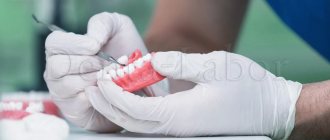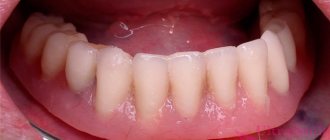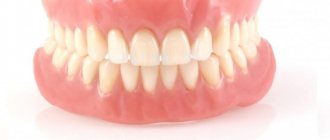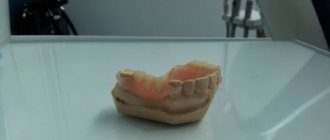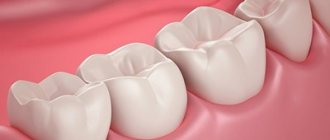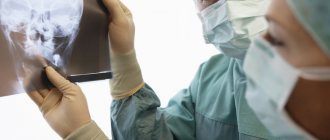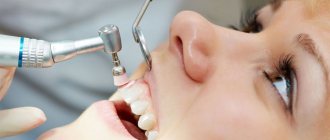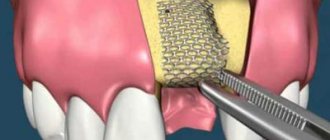- When is denture relining necessary?
- Contraindications for prosthesis relining
- Laboratory relocation
- Relining the prosthesis price
- Features of the clinical method
- Laboratory method for relining a prosthesis
Attachment of removable dentures during prolonged wear with intense loads loses functionality.
Gradual weakening of locks or hooks requires relining of the removable denture. It is not difficult to determine that you need to contact a specialist for help. During a conversation or eating, gradually progressive discomfort begins to appear. Relining the removable denture will ensure a tight fit of the structure and will completely normalize the bite. By postponing a visit to the orthodontist, people expose the oral mucosa to danger and the likelihood of injury increases.
Symptoms that should not delay a visit to the dentist
You should make an appointment with an orthodontist if:
- changes in the alveolar process of the upper jaw appear;
- the prosthesis has received damage that is not visible to a specialist, or significant flaws have appeared after prolonged wear;
- the height of the lower third of the face has undergone atypical changes. At the same time, the minimum initial deviations rapidly increase;
- The relief of the oral mucosa changes dramatically during prosthetics or after prolonged use of a stationary prosthesis.
Indications for the procedure
Those who wear removable dentures need to visit a doctor once every six months for consultation and necessary relining. The procedure is necessary in the following cases:
- visible defects on the prosthesis;
- change in gum relief due to prolonged wear;
- unreliable fixation of the removable structure;
- transformation of the lower part of the face (height).
You cannot reline a prosthesis if it has significant defects and damage: in this case, a replacement is required. In case of inflammatory diseases of the oral cavity, relining is carried out only in laboratory conditions, but with the possibility of making impressions.
If the patient has an allergic reaction to plastic, a special laboratory will also be needed to reline the dentures.
Contraindications
Relining a removable denture is not done if:
- damage to the structure occurred due to a strong impact on a hard object or other mechanical impact that violated the integrity of the system;
- the prosthesis no longer meets the standards necessary for its continued wearing due to loss of integrity;
- there are one or more broken elements;
- anatomical retention is impaired, in which the prosthetic bed is not able to hold the prosthesis;
- The structure is unstable and can fall apart into its component parts at any moment.
The above reasons indicate the futility of relining a removable denture, since urgent production of a new system is required.
Indications for correction
Modification or repair of a removable denture is carried out if it rubs soft tissues, causes irritation and pain. Prolonged pressure provokes deformation of the upper and lower jaw, therefore, if you feel discomfort, you should not hesitate. The main indications for correction are:
- excess pressure on the mucous membrane;
- weak fixation due to errors made during production;
- deformation of the hooks holding the structure on the supporting teeth;
- cracks in the plate material;
- the appearance of gaps between teeth;
- fracture of the base due to trauma.
Advantages of the Denta-Labor team
- Many years of experience More than 20 years in the dental services market
- Modern equipment Expert class dental devices
- Denta-Labor's own training center conducts training courses for dental technicians in Moscow
- Individual approach The client’s wishes and existing orthopedic problem are taken into account
- No unnecessary additional services Completion of work according to a pre-agreed estimate
- Courier delivery We will deliver the dentures as soon as possible
Relocation technique
Orthodontists use two main types of denture relining.
- Clinical . It is limited by the patient’s intolerance to certain synthetic components that cause allergies, or chronic diseases of the oral mucosa.
- Laboratory . The most secure, reliable, convenient.
Only the attending physician chooses a technique based on the patient’s current condition, associated issues, and clinical picture.
Plastics for repairing denture relines. Composition properties and features of work
The introduction of self-hardening (quick-hardening) plastics into practice has made it possible to simplify individual stages of prosthesis manufacturing, reposition a worn-out plastic base without thermal polymerization, and repair a fixed combined prosthesis (metal and plastic) directly in the oral cavity. Self-hardening plastics have the ability to polymerize at normal air or human body temperatures, combine well with other types of plastics without thermal polymerization, and do not have a harmful effect on the body and oral organs. The most common domestic self-hardening plastics at present are stadont, noracryl-100, protacryl, redont.
Protacryl
Protacryl belongs to the group of self-hardening plastics and is used for repairing removable dentures, relining plastic bases in case of disruption of adhesiveness and functional suction, and for the manufacture of orthodontic appliances. Protacryl is produced by the Kharkov plant of medical plastics and dental materials. Protacryl contains powder and liquid. The powder is a mixture of fine polymethyl methacrylate 96.5%, benzoyl peroxide 1.5% and disulfanamine 2% (activator). The powder is colored pink by Sudan.
The liquid is methyl methacrylate. Dimethylparatoluidine is added to it as an activator in an amount of 0.1-0.2%. The original plastic packaging of protacryl contains: powder in a plastic bag—160 g, liquid in a bottle—100 g, release varnish in a bottle—50 g, and dichloroethane glue in a bottle—40 g.
Protacryl has the ability to monolithically chemically combine with base materials of the acrylic group, has sufficient strength, does not change its color in the oral cavity, and is similar in physical and mechanical properties to the plastic Ethacryl.
Application of protacryl. Protacryl is used for repairing removable dentures, relining and manufacturing orthodontic appliances.
Redont
Plastic for correcting dentures. Redont is a self-hardening plastic that belongs to the acrylic group. Redont is used to correct (reline) removable plastic dentures in case of a violation of the fit to the mucous membrane
oral cavity or violation of fixation of the base to natural teeth. Redont is used for the manufacture of orthodontic appliances of various designs. Redont consists of powder and liquid.
The powder is a finely dispersed copolymer of methyl and ethyl esters of methacrylic acid, colored pink with fatty dyes. The ratio of methyl and ethyl esters is 90:10. For orthodontic purposes, the polymer is produced without opacifier - transparent. The catalyst is benzoyl peroxide.
The liquid is methacrylic acid methyl ester; dimethylparatoluidine and stabilizer hydroquinone are added to the liquid as a catalyst. There are two bottles in the original packaging: powder - 150 g; liquid - 100 g.
Relocation cost
| Name | Price from | |
| Relining a partial denture | excluding cost of prints | 5500 rub. |
| Relining a complete removable denture | excluding cost of prints | 5500 rub. |
| Repair of acrylic prosthesis | simple, excluding the cost of prints | 3000 rub. |
| Repair of acrylic prosthesis | average, excluding cost of prints | 3000 rub. |
| Repair of acrylic prosthesis | complex, excluding the cost of prints | 3000 rub. |
| Taking impressions | Complex | 2000 rub. |
Indications for relining the prosthesis
This procedure is usually recommended if discomfort occurs while talking or eating. It allows you to improve the fit of the structure and ensure adequate closure of the jaws.
The relocation is carried out -
- if there are defects in dentures,
- in case of poor-quality impression taking,
- deterioration of the aesthetic parameters of the dental structure,
- when the prosthesis does not fully perform its chewing function.
This procedure is also necessary if the prosthesis injures the tissues of the oral cavity.
Features of the clinical method
- Complete examination of the oral cavity, checking the integrity of the prosthesis.
- After analyzing the bite, the size of the marginal area is adjusted. The long one is cut off. Short - extended using quick-hardening plastic substances.
- A small layer of 1 mm will be removed from the prosthesis. The edge fragment loses polishing.
- Thorough impregnation of artificial elements with Vaseline.
- The boundaries of the marginal area are completely treated with a liquid polymer mixture.
- After the outer layer becomes dull, the prosthesis is put on by the patient. It is necessary to close your jaws tightly and hold in this position for a couple of minutes.
- The system is then polymerized in special equipment.
- After ten minutes of treatment, the prosthesis is removed to be adjusted manually. In the finale, he is immersed in hot water.
The advantages of clinical relining of a removable denture include the rapid elimination of existing deficiencies, as well as ideal accuracy. The disadvantages include the high porosity of the material, which reduces the hygiene of the system, and color changes.
Price
The cost of the service is determined not only by the method of its implementation, but also by the following direct and indirect factors.
Direct:
- price of the material used;
- equipment used;
- the size of the structure and the volume of work carried out.
Indirect:
- region of residence – as practice shows, in metropolitan clinics and large cities this service costs 15–20% more than in small towns and settlements;
- status of the medical institution and the level of professionalism of the doctor.
On average, based on the above, the cost of the procedure looks something like this:
- clinical relocation – from 3,700 rubles;
- laboratory - from 6,200 rubles.
It is worth noting that if prosthetics and subsequent relining of the structure are carried out in one place, very often clinics offer good discounts to their regular customers.
Relining of removable dentures using the laboratory method
- The work is performed by a technician in a laboratory.
- The degree of wear of the prosthesis, quality of manufacture, and tightness of fit in the mouth are assessed.
- A control impression is made for transmission to the doctor.
- The surface of the prosthesis undergoes special treatment.
- A copy of the impression and the system are lowered into a ditch, after which they are filled with diluted plaster.
- The cast is taken out, and the resulting void is filled with polymerizing plastic.
- The excess is cut off, after which the product is polished.
The main advantages of the laboratory technique include the absence of contact between the mucous membrane and the plastic, a strong connection between the old and new layers, and an excellent aesthetic appearance. The disadvantages include the length of the process. The patient is forced to go without a prosthesis for several days; errors are possible that require additional time to eliminate defects.
Laboratory method
Work in the laboratory is carried out in cases where the prosthesis is manufactured for the first time and in cases of serious violations committed during manufacturing. And also with reduced bite heights. In this case, harmful toxins do not affect the mucous membranes of the mouth, and the product looks more aesthetically pleasing than with the clinical method.
- The prosthesis is removed and sent to the laboratory, where the top layer of plastic is removed.
- New dental impressions are taken from the patient.
- The old denture and the new impression are placed in a mold into which the plaster mixture is poured.
- The impression is then removed and the space is filled with a polymer material that bonds to the item.
- At high temperatures, the applied material polymerizes.
- The finished structure is removed, cleaned of excess and polished.
- The prosthesis is tried on the patient. If necessary, the bridge is adjusted again.
- If a person does not experience discomfort during installation, chews easily, closes his jaws, the relining is completed.
The big disadvantage of this method is the length of the wait and the need to visit the doctor several times. Production time takes from two to five days.
Frequently asked questions - answers:
Which prosthesis is better to choose - domestic or imported?
Perhaps, from an aesthetic point of view, our products are inferior, but in practice they turned out to be much stronger and more reliable than imported dentures.
Why is the denture, which I have been using for less than a year, constantly getting in the way and falling out? This has already begun to cause psychological discomfort.
The implant was simply not adjusted to the end. We advise you to do a relocation; do not worry, there is nothing painful or scary in this procedure.
Why do I need to reline the prosthesis if nothing bothers me?
Reliable fixation of the prosthesis is an extremely important condition for the full functioning of the entire dental system. And, of course, comfort. Any artificial teeth need to be looked after - cleaned and regularly shown to an orthopedic dentist.
To order denture relining in the dental laboratory Denta-Labor, send a request from the website or call the number: +7(495) 162-08-25.
Dyatlov Evgeniy Valerievich
Head of the Denta-Labor laboratory and teacher at the training center organized at the laboratory.
Graduated from Stavropol Basic Medical College.
Author of the article: Scientific team of the dental laboratory Denta-Labor
- Studied in Germany with Dr. Karl Peter Meschke in the course of complete removable prosthetics.
- I attended a course of lectures at the German Dental Academy based at BEGO (Bremen).
- Completed a week-long internship in Germany at the BEGO company on new technologies and materials for removable prosthetics.
Correction methods
The dentist can use two methods to correct removable orthopedic dentures. For articulation testing, the following algorithm of actions is used:
- the doctor installs the prosthesis;
- checks the reliability of fixation;
- inserts articulation paper between the teeth;
- invites the patient to close his jaws and move his teeth forward and to the sides;
- grinds paper-painted points on a removable denture with a milling cutter;
- makes a re-check and, if necessary, repeats the manipulation.
The method makes it possible to detect protruding areas of artificial teeth that interfere with chewing food and closing the jaws.
If there are gaps between the gums and the denture, bring it in for relining as soon as possible.
The basis correction occurs differently:
- the dentist removes the orthopedic structure;
- paints the mucous membrane with a chemical pencil;
- puts on the prosthesis and invites the patient to move his jaw;
- removes and checks the product;
- The painted areas are smoothed with a special device and the fitting is repeated.
When the prosthesis has metal parts, the fitting is carried out with the utmost care. The components are shaped and sanded to remove sharp edges.
If the base is cracked, the doctor selects repair options individually, focusing on the complexity of the breakdown. Most often, the rupture site is cleaned and filled with a suitable polymer. After the substance hardens, the area is polished and given the necessary relief.
Clinical method
If the prosthetic bed does not correspond to the base due to technical defects or bone tissue atrophy, the structure needs to be rebased. To correct the situation, clinical and laboratory methods are used.
- In the first case, the dentist checks the bite with articulation paper, examines the prosthesis and corrects the protruding areas.
- Afterwards, a layer of material 1 mm thick is removed from the surface of the product facing the mucosa.
- In the vestibular part of the prosthesis, carefully clean off the polish and lubricate the crowns with Vaseline.
- Self-hardening plastic is mixed. The swollen mass is applied in an even thin layer to the base, wait 15 seconds and inserted into the patient’s oral cavity.
- Excess material is squeezed onto the surface of the base in the area of the soft palate. They are carefully removed with a spatula.
- After 2 minutes, the structure is removed from the mouth and placed in the apparatus, where final polymerization occurs.
If the base is cracked, the doctor will try to repair it.
After clinical relining, the microrelief of the oral cavity is clearly displayed on the base, and the fixation of the prosthesis is significantly improved. The patient receives the finished product in 30-60 minutes.
Laboratory method
If plastic intolerance or mucosal pathology is diagnosed, the clinical method for relining cannot be used. For such patients, a laboratory method is recommended.
- An impression is made using dentol, orthocor or other modern materials. The dental technician plaster the structure with the impression in a direct way, remove it from the mouth, replace it with plastic and carry out polymerization.
- The advantage of the laboratory method is that the self-hardening plastic does not come into contact with the oral cavity in an uncured form, and the new base layer is completely no different from the previous one.
- Among the disadvantages, it is worth noting the high price and the fact that technical errors often occur with the laboratory relining method. It takes a day to repair.
Reviews
— Albert
I really liked the level of service and attitude of the staff.
- Eugene
They saved me, there’s no other way to put it. Thank you for the speed and decency. Everything as promised!! I recommend to all!!!
- Svetlana
This is not the first time we have used denture repair services. As always FAST AND HIGH QUALITY! Thank you for your promptness and understanding!!
— Ksenia Vladimirovna
My daughter’s denture broke on the eve of her wedding, I was very upset, but Denta-Labor managed to fix it very quickly and efficiently, thank you.
Delivery areas:
- Altufyevo
- Bibirevo
- Biryulyovo East
- Central Administrative District
- Chertanovo
- Golyanovo
- Krasnopresnenskaya
- Kuntsevo
- Kuzminki
- Odintsovo
- Lyublino
- Medvedkovo
- Mitino
- Otradnoe
- Pavshinskaya floodplain
- Printers
- Polezhaevskaya
- River Station
- Ryazan Avenue
- SAO
- Northern Butovo
- Sokolniki
- NEAD
- SZAO
- Tushino
- Southern Administrative District
- SEAD
- South-Western Administrative District
- Voikovskaya
- Vykhino
- Company
- Zhulebino
- Aprelevka
- Dubki
- Krasnoznamensk
- Krylatskoe
- Cuban
- Nazaryevo
- Barvikha
- Vlasikha
- VNIISSOK
- Vnukovo
- Larks
